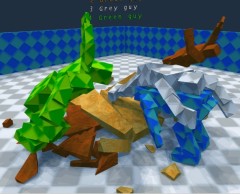

Plus, it’s only 87k and it’s completely free. I’d love to see Peter keep tweaking the physics to massage the gameplay to a more advanced state, but even now Sumotori is a fun party game. Granted, a video game can tweak the rules of physics where a physical robot cannot, but it’s still a great achievement. Sumotori is awfully impressive–self-balancing bipeds are a very difficult domain, even in the scope of “serious” research. ( Sumotori Dreams Game Screenshots) Impressive Implementation

Matches are over quickly very few engagements lasted more than a push or two before one of the characters would completely lose its footing. The victors in many of our battles were simply the rig that fell second, even before the rigs were touching. It seems more productive to do small, controller movements, or sometimes not move at all. It’s especially punishing if your play style is aggressive. The actual locomotion is a product of the rig self-righting itself to compensate for the new imbalance.Īs a result, it can be frustrating to play Sumotori. Even moving around is a little spastic–it looks like your input doesn’t control the rig directly, but rather nudges it off-balance. The physics ragdoll rigs are self-balancing, so they’re in constant autonomous motion whenever they’re off balance (which is 100% of the time as soon as you engage your opponent). The control system in Sumotori is once removed. It’s great fun to watch them smash things in their desperate attempt to right themselves. If you let the ragdoll men stagger around a bit after a match they’ll usually end up in the walls, too. I spent a few minutes just destroying them in the game’s hidden mode (shoot between the right-most slat to destroy the near corner wall on the title screen). The destructible walls provide a great sense of impact. Even ignoring its miniscule size, the physics engine stands alone as innovative. It’s worth mentioning that Sumotori is a technical masterpiece.


 0 kommentar(er)
0 kommentar(er)
